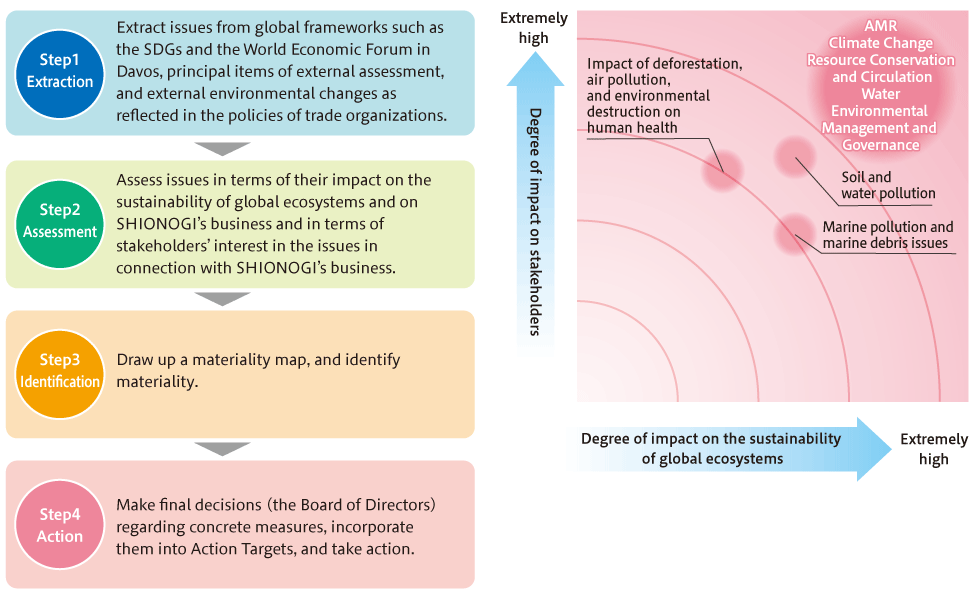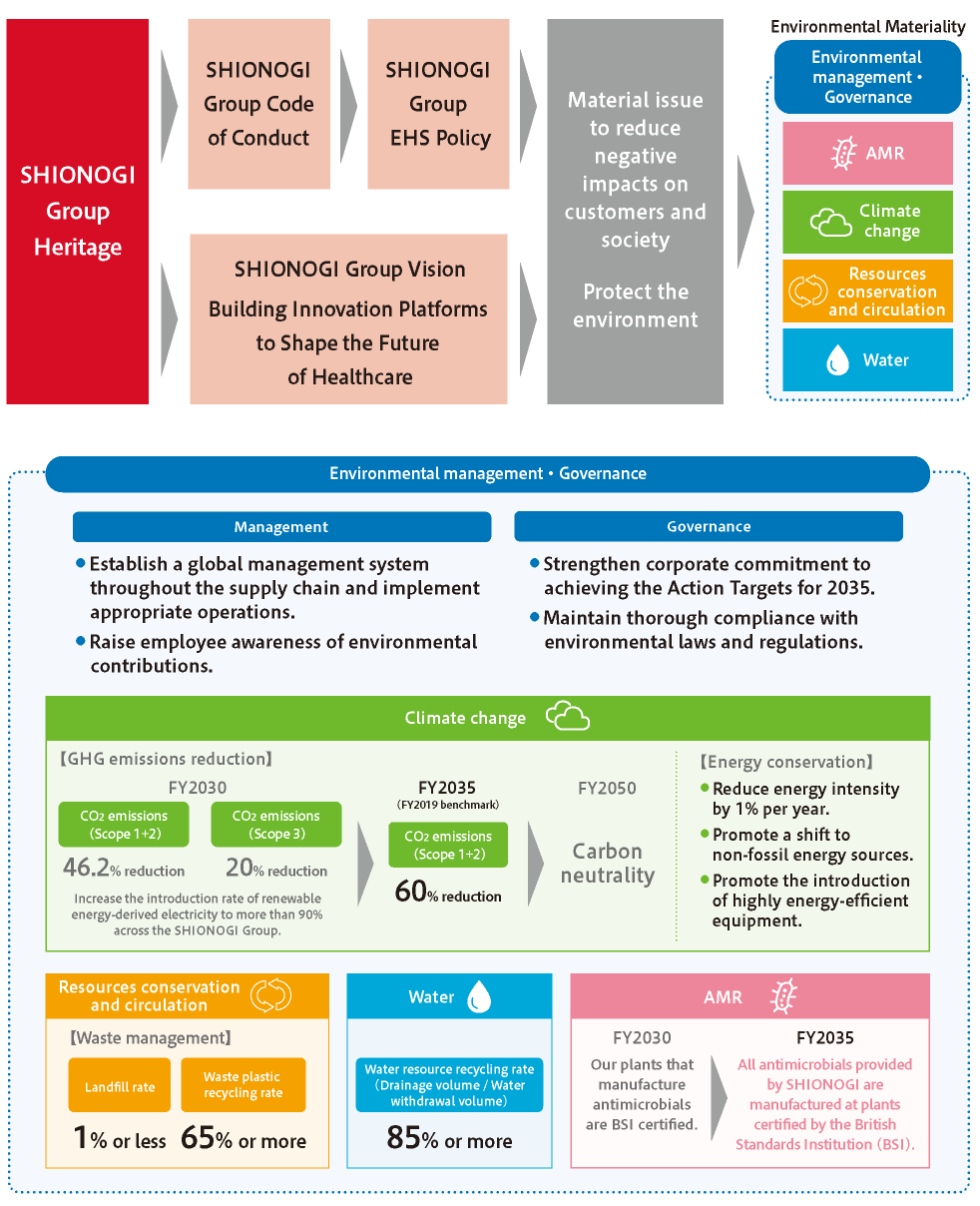Environmental Materiality
In addition, we have listed environmental issues to be addressed through deeper exploration of relevant changes in the external business environment and dialogue with external stakeholders, such as ESG investment institutions and external experts, and related organizations within the company. By assessing the impact of these issues on the sustainability of global ecosystems and on stakeholders based on the Environmental Reporting Guidelines published by the Ministry of the Environment, Japan, we have identified Environmental Materiality as priority environmental issues that SHIONOGI should address. For the identified Environmental Materiality, we have formulated specific medium- and long-term targets for resolving the issues as the SHIONOGI Group EHS Action Targets. We also create a single-year EHS Action Plan each year and continue to implement and review it, while reflecting its results in the following year’s targets, in order to ensure effective responses.
The SHIONOGI Group EHS Action Targets are determined through deliberation by the Corporate Executive Meeting and the Board of Directors after discussion by the SHIONOGI Group Companywide EHS Committee. Meanwhile, the EHS Action Plan is determined under the responsibility of the Senior Executive Officer and Senior Vice President of the Administration Division, who serves as the Corporate Officer in charge of EHS, after deliberation by the SHIONOGI Group Companywide EHS Committee.
Regarding environmental issues, there has been increased activity in society looking beyond 2030, as the IPCC*1 Sixth Assessment Report (released in March 2023) indicated that it is necessary to reduce GHG emissions by 60% by 2035 compared to the 2019 level. Moreover, as SHIONOGI’s business activities expand, its new operating sites are increasing both in Japan and overseas, leading to a growing need to appropriately respond on a global scale to global environmental issues such as climate change, environmental pollution, and the depletion of natural capital. In FY2023, in light of these changes in the situation both inside and outside the company, we reassessed the environmental issues that SHIONOGI should address. As a result, SHIONOGI has identified “advancing our response to the environment more strategically and with a sense of unity on a global scale” as a material issue that we should address. Accordingly, it was resolved by the Board of Directors that “environmental management and governance” should be identified as a new Environmental Materiality in addition to the four previously identified items (AMR, climate change, water and water risks, and resource conservation and circulation).

Summary of identification of Environmental Materiality
Material issues |
Summary of identification |
|---|---|
| AMR | This is a global issue that a pharmaceutical company manufacturing antimicrobials cannot ignore. The emergence of AMR impacts global ecosystems enormously. |
| Climate change | Responding to climate change is essential for the sustainability of global ecosystems. Meanwhile, stakeholders’ demand for action in this regard is growing increasingly strong. |
| Resources conservation and circulation | Reducing waste and circulating resources mean effectively utilizing limited resources and are essential for the sustainability of global ecosystems. This is a part of the problem of marine plastic, and stakeholders’ interest in this international issue has been growing in recent years. |
| Water | With the growing probability of occurrence of torrential rainfalls and floods, water risks (particularly physical risks) must be closely watched from the perspective of BCP. Water is an indispensable factor for the business continuity of pharmaceutical companies and essential for the sustainability of global ecosystems. |
| Environmental management and governance | As SHIONOGI’s business activities expand, its operating sites are increasing globally. In this situation, SHIONOGI needs to respond appropriately to global environmental issues such as climate change, environmental pollution, and the depletion of natural capital, and demonstrate the results of its efforts to stakeholders. |
We apply the identified Environmental Materiality to the value chain and consider what countermeasures are required for each material issue in each process. The countermeasures are reflected in the SHIONOGI Group EHS Action Targets.
To offer value to society and meet our stakeholdersʼ expectations, the SHIONOGI Group hopes to further deepen its activities by clarifying concrete steps toward handling material issues in the future and key performance indicators (KPIs).
Environmental Materiality and the value chain
|
Purchase |
R&D |
Manufacturing |
Distribution and sales |
Use and disposal |
|---|---|---|---|---|---|
AMR |
Antimicrobial release management |
|
Antimicrobial release management |
|
Promotion of responsible antimicrobial use |
Climate change |
Introduction of energy-saving equipment |
Introduction of energy-saving equipment |
Introduction of energy-saving equipment |
Introduction of hybrid vehicles |
Change in or recycling of containers and packaging materials |
Resource conservation and circulation |
Green purchasing |
Design of environmentally responsible products |
3Rs of waste materials |
|
Reuse and recycling of containers and packaging materials |
Water |
Water risk assessment |
Water risk assessment, water conservation, wastewater management |
Water risk assessment, water conservation, wastewater management |
|
|
| Environmental management and governance | Establishment and strengthening of an environmental management and governance structure at each business site and organization of SHIONOGI | ||||
Environmental Materiality and the SHIONOGI Group EHS Action Targets (Environment)

